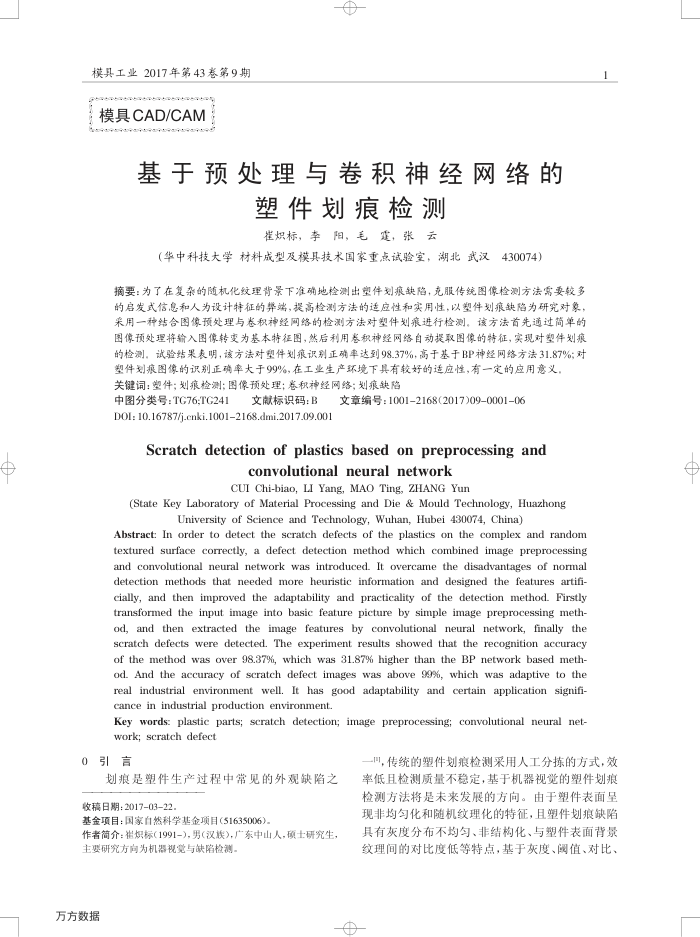您当前的位置:首页>论文资料>基于预处理与卷积神经网络的塑件划痕检测
内容简介
 模具工业2017年第43春第9期模具CAD/CAM
模具工业2017年第43春第9期模具CAD/CAM基于预处理与卷积神经网络的
塑件划痕检测崔炽标,李阳,毛霆,张云
(华中科技大学材料成型及模其技术国家重点试验室,湖北武汉430074)
摘要:为了在复杂的随机化纹理背景下准确地检测出塑件划痕缺陷,充服传统图像检测方法需要较多的启发式信息和人为设计特征的弊端,提高检测方法的适应性和实用性,以塑件划痕缺陷为研究对象,采用一种结合图像预处理与参积神经网络的检测方法对塑件划进行检测。该方法首先通过简单的图像预处理将输入图像转变为基本特征图,然后利用参积神经网络自动提取图像的特征,实现对塑件划痕的检测,试验结果表明,该方法对型件划痕识别正确率达到98.37%,高于基于BP神经网络方法31.87%;对
塑件划痕图像的识别正确率大于99%,在工业生产环境下具有较好的适应性,有一定的应用意义,关键词:塑件;划痕检测;图像预处理;卷积神经网络;划痕缺陷
中图分类号:TG76;TG241
文献标识码:B
D0I: 10.16787/j-cnki.10012168.dmi.2017.09.001
文章编号:10012168(2017)09-0001-06
Scratchdetectionofplasticsbased onpreprocessingand
convolutional neural network
CUI Chi-biao, LI Yang, MAO Ting, ZHANG Yun
(State Key Laboratory of Material Processing and Die & Mould Technology, Huazhong
University of Science and Technology, Wuhan, Hubei 430074, China)
Abstract: In order to detect the scratch defects of the plastics on the complex and random textured surface correctly, a defect detection method which combined image preprocessing and convolutional neural network was introduced. It overcame the disadvantages of normal detection methods that needed more heuristic information and designed the features artifi-cially, and then improved the adaptability and practicality of the detection method. Firstly transformed the input image into basic feature picture by simple image preprocessing meth-od, and then extracted the
imagefeaturesby
convolutional neural network, finally the
scratch defects were detected. The experiment results showed that the recognition accuracy of the method was over 98.37%, which was 31.87% higher than the BP network based meth od. And the accuracy of scratch defect images was above 99%, which was adaptive to the real industrial environment well. It has good adaptability and certain application signifi-cance in industrial production environment.
Key words: plastic parts; scratch detection; image preprocessing; convolutional neural net-work; scratch defect
0引言
划痕是塑件生产过程中常见的外观缺陷之收稿日期:20170322
基金项目:国家自然科学基金项目(51635006)。
作者简介:崔炽标(1991-),男(汉族),广东中山人,硕士研究生,主要研究方向为机器视觉与缺陷检测
万方数据
1
日,传统的塑件划痕检测采用人工分抹的方式,效率低且检测质量不稳定,基于机器视觉的塑件划痕检测方法将是未来发展的方向。由于塑件表面呈现非均勾化和随机纹理化的特征,且塑件划痕缺陷具有灰度分布不均勾、非结构化、与塑件表面背景纹理间的对比度低等特点,基于灰度、阀值、对比、